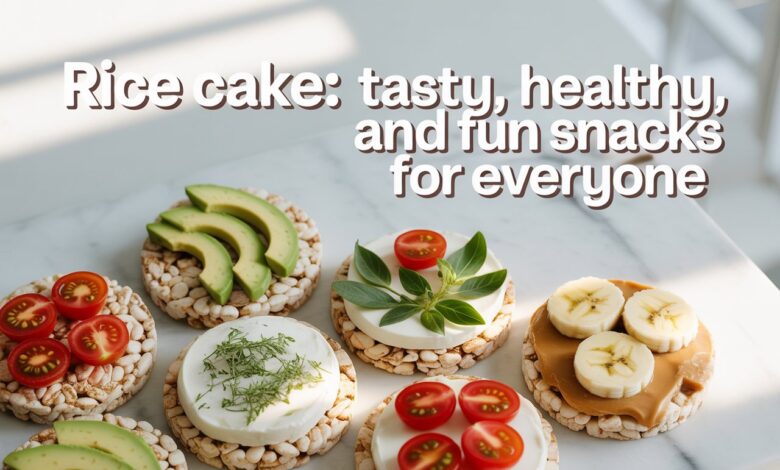Rice Cake: Tasty, Healthy, and Fun Snacks for Everyone

What Is a Rice Cake?
A rice cake is a fun snack made from rice. People puff up rice grains to make light, crunchy disks. These come in plain or flavored types like caramel or chocolate. Rice cakes are low in calories, about 35 per piece. They have little fat and some protein. Brown rice cakes offer more nutrients than white ones. Kids love them because they crunch when you bite. You can eat them alone or add toppings like peanut butter or fruit. Rice cakes started as a healthy choice for diets. Now, everyone enjoys them as a quick bite. They are gluten-free too, good for many people. Try a rice cake next time you want something light and tasty. This makes rice cake a great option for snack time.
The History of Rice Cake
Rice cake has a long story that goes back thousands of years. Rice grew in Asia over 9,000 years ago. People made early rice cakes by pounding rice into dough. In China, sticky rice cakes date to 2,500 years old. They used them for festivals and luck. In Korea, tteok rice cakes came from ancient times too. They shared them as gifts when rice was rare. Southeast Asia likely started rice cakes first, where rice farming began 5,000 years back. In the US, puffed rice cakes became popular in the 1980s as diet food. Companies like Quaker made them famous. Today, rice cake mixes old traditions with new flavors. Kids can learn about cultures through these treats. The history shows how simple rice turned into a world favorite. Rice cake connects past and present in yummy ways.
Types of Rice Cake Around the World

Colorful Korean tteok rice cakes.
Rice cake comes in many kinds from different countries. In Japan, mochi is a chewy rice cake made from glutinous rice. People eat it plain or filled with sweet bean paste. Korean tteok includes garaetteok, long cylinders used in soups. Songpyeon is half-moon shaped for holidays. In the Philippines, bibingka is baked with coconut. India’s idli is a savory steamed rice cake for breakfast. China has nian gao, sticky cakes for New Year luck. African countries make masa from fermented rice. Each type uses local ingredients and methods. Some are sweet, others savory. Puffed rice cakes in the US are crunchy snacks. Trying these shows how rice cake changes with culture. Kids can have fun tasting global versions at home or stores. Rice cake brings the world to your plate.
Korean Rice Cake Varieties
Korea has over 200 types of tteok rice cake. Injeolmi is coated with bean powder and chewy. Garaetteok is plain and used in tteokbokki, a spicy dish. Songpyeon gets stuffed with sesame or beans for Chuseok festival. Jeungpyeon is steamed and fluffy like bread. Omegi-tteok from Jeju Island uses millet. These rice cakes mark special days like births or weddings. People pound rice flour to make them sticky. Some add colors from natural things like mugwort. Kids in Korea eat them as treats or in meals. Tteok shows Korean history and sharing spirit. You can find frozen tteok in Asian stores. Try making simple ones at home for fun. Korean rice cake teaches about traditions while tasting great. Explore these to add excitement to snacks.
Japanese Rice Cake: Mochi and More

Assorted Japanese mochi rice cakes.
Japan’s mochi is a famous rice cake. Made by pounding sticky rice, it gets soft and stretchy. People eat it grilled or in soup for New Year. Daifuku mochi has fillings like strawberry or ice cream. Kinako mochi rolls in soybean flour. Senbei are crunchy grilled rice crackers, different from soft mochi. Arare are small popped rice bits with flavors. These rice cakes appear in festivals and daily life. Kids pound mochi in games at events. Mochi warns of choking if eaten too fast. Always chew well. Japanese rice cake mixes sweet and savory tastes. You can buy mochi mix to make at home. It teaches patience and culture. Enjoy mochi safely for a fun treat. Rice cake in Japan is full of joy.
Health Benefits of Rice Cake
Rice cake offers good health perks. Made from whole grains, brown rice cake has fiber for digestion. It gives energy from carbs without much fat. One rice cake has about 35 calories, great for weight control. It provides manganese for bones and B vitamins for energy. Gluten-free, it suits many diets. Pair with protein like nut butter for better nutrition. Bodybuilders eat rice cake for quick carbs before workouts. It helps refill energy stores. Kids get a healthy snack instead of junk food. But eat in balance, as plain ones lack some nutrients. Add fruits or veggies for more vitamins. Rice cake supports active lifestyles. Choose organic for no chemicals. This snack keeps you feeling good. Rice cake is smart for health.
Nutrition Facts About Rice Cake
A plain rice cake has 35 calories. It includes 7 grams of carbs, 1 gram protein, and no fat. Fiber is low at 0 grams, but brown types add some. Niacin is 4% of daily needs for energy. Manganese helps with metabolism. Sodium is low unless flavored. Chocolate rice cake adds 60 calories with a bit of fat. Ingredients are simple: puffed rice and salt. No high fructose syrup in basic ones. For kids, this means light snacks without sugar crashes. Compare to chips, rice cake wins on calories. Track portions for balanced eating. Nutrition makes rice cake a wise pick. Read labels for added stuff. This knowledge helps choose well. Rice cake fuels bodies right.
Are Rice Cakes Good for You?
Yes, rice cakes can be healthy. They are low calorie and fat-free. Brown rice cakes give whole grains for heart health. They lack gluten, helping those with allergies. But alone, they miss fiber and protein. Top with avocado or eggs for balance. This stops blood sugar spikes. Dietitians say pair them with nutrients. For kids, rice cake teaches healthy eating. Avoid too many flavored ones with sugar. Plain is best for control. Studies show whole grains cut disease risk. Rice cake fits in varied diets. Listen to your body for portions. This snack supports wellness when used smart. Rice cake boosts good habits.
How to Make Rice Cake at Home
Making rice cake at home is easy and fun. Start with 1 cup uncooked rice and 1.5 cups water. Cook rice until soft. Mix in 2 eggs and 2 tablespoons flour. Add salt or flavors like cheese. Form into patties. Fry in a pan with oil until golden. This takes 10 minutes. For puffed style, use a machine or oven bake. Kids can help shape them. Use brown rice for health. Add veggies for taste. Store in fridge for days. This saves money over store buys. Try different spices for variety. Homemade rice cake tastes fresh. Share with family for bonding. It’s a simple kitchen adventure. Make rice cake your way.
Simple Recipes with Rice Cake
Try peanut butter banana rice cake. Spread peanut butter on a rice cake. Top with banana slices and cinnamon. It’s sweet and filling. For savory, add avocado and tomato. Mash avocado, add salt, top with slices. Kids love strawberry cream cheese. Spread cheese, add berries. Use hummus and cucumber for crunch. These take minutes. For dessert, chocolate spread and nuts. Rice cake works as base. Experiment with favorites. This makes snacks healthy. Share recipes with friends. Rice cake recipes are endless. They teach creativity in eating. Enjoy making and munching. Rice cake sparks ideas.
Fun Facts About Rice Cake
November 29 is National Rice Cake Day. Celebrate with extras. Rice cakes pop under high heat and pressure. Like popcorn but rice. In myths, a crow saved a king with rice cake. They inspired stories. Thin ones are light, thick chewy. Over 500 million eat them worldwide. First developed in Asia 5,000 years ago. US sales boomed in 80s for diets. Some rice cakes have colors from plants. Kids can learn science from puffing. Rice cake facts amaze. Share at parties. This snack has hidden wonders. Rice cake is full of surprises.
Why Kids Love Rice Cake
Rice cake is crunchy and fun to eat. Kids like the pop sound. It’s light, not heavy like bread. Add fun toppings like faces with fruit. No mess if plain. Parents give it for quick energy. Gluten-free for sensitive tummies. Flavors like apple cinnamon taste like treats. Rice cake helps picky eaters try new things. Pack in lunches for school. It’s affordable too. Kids feel big making their own. This snack grows with them. From babies to teens, rice cake fits. Encourage healthy choices early. Rice cake wins kids’ hearts.
Rice Cake in Festivals and Culture
In China, nian gao rice cake means growing taller for New Year. Koreans eat tteok soup for birthdays. Japanese mirror mochi for luck. Filipinos have puto at parties. These rice cakes symbolize joy and prosperity. Families make them together. Kids learn heritage through food. Festivals feature special types. Rice cake builds community. Try cultural recipes at home. This connects to world traditions. Rice cake tells stories of people. Celebrate with a bite. Rice cake enriches life.
Tips for Choosing and Storing Rice Cake
Pick brown rice cake for more nutrients. Check labels for no added sugar. Flavored ones add fun but calories. Store in airtight bags to keep crisp. Away from moisture. Last months if sealed. Freeze homemade for longer. Buy from trusted brands like Quaker. For kids, small packs prevent waste. Rotate flavors for variety. This keeps rice cake fresh. Smart choices make snacking better. Enjoy rice cake at best.
Conclusion
Rice cake is a wonderful snack full of history, health, and fun. From Asian traditions to modern bites, it pleases everyone. Kids and adults find joy in its crunch and versatility. Make some at home or try new types. This simple food brings big smiles. Start your rice cake adventure today. Grab a pack, add toppings, and share with loved ones. Your taste buds will thank you!



